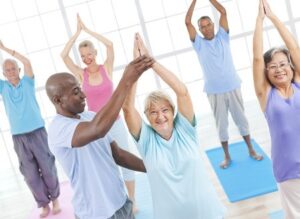Exercise may be the furthest thing from someones mind after a cancer diagnosis. Even if they have never been active, exercise can become one of your favorite activities. With more medical professionals recommending exercise to their patients, it is imperative for cancer survivors to learn how to exercise safely. First, have them ask their doctor before you start because each person is unique and heals differently.
A good exercise program will help reduce the side effects of surgery and treatments. These side effects can include fatigue, neuropathy, decreased range of motion, weakness, lymphedema, balance issues, and a significant emotional toll. This article discusses the importance of adding balance exercises to the exercise plan.
Balance exercises will help them regain function and mobility for activities of daily living. Balance can suffer after surgical procedures, especially with the TRAM flap procedure. A TRAM (transverse rectus abdominis myocutaneous) flap consists of skin, fat, rectus muscle, and blood vessels taken from the abdominal wall and transferred to the chest to reconstruct the breast. Because these muscles help with strength, posture, balance, and flexibility, TRAM flap surgery can weaken the body’s core. After a TRAM flap operation, they will need to learn how to compensate for this change of muscle placement through a series of exercises designed to strengthen the remaining muscles.
Balance exercises can counter some of the effects of muscle imbalances and body asymmetry after surgery. Some chemotherapy treatments can affect balance and cause neuropathy. Neuropathy, which can make feet numb, is a common side effect of chemotherapy. If someone cannot feel their feet, it becomes difficult to maintain good balance. You should incorporate balance exercises as a regular part of their fitness routine to learn how to compensate.
Balance exercises can help prevent future injuries, such as falls. Balance training will help decrease the likeliness of falling. After a fall, activities are sometimes limited, which can make it difficult to live independently. Cancer survivors are sometimes at higher risk for osteoporosis due to cancer medications. When someone is nervous about falling, they might withdraw from their daily activities and have a lower quality of life. Balance and strength exercises can help prevent falls by improving ability to control and maintain body position whether in motion or stationary.
Improve Balance and Lower Body Strength
Start balance exercise routines with the following exercises. Provide a chair to hold for support at the beginning. With improvement, holding the chair can be done with only one hand or even one finger. The goal is to eventually do these without holding the chair at all. For an added challenge, try these exercises with the eyes closed:
Standing on one foot: Hold for 10 seconds then switch legs.
Tightrope: Put heel in front of toe of the other foot as if walking a tightrope.
Calf or heel raises: Stand in place and slowly raise each calf (or heel) up and down.
Front, back, and side leg lifts or raises: Standing in place, lift leg to the front, back, or side.
Grapevines: Step sideways while crossing one foot in front of the other. On the next step, cross the foot in back of the other.
Improve Core Strength
Pelvic tilt: Lie on back with your knees bent and feet flat on the floor. Inhale and fill torso with air. Exhale while pressing abdominals downward, bringing navel to your spine. Lower and repeat for 5 to 10 reps.
Bridge: Lie on back with your knees bent and your feet flat on the floor. Squeeze glutes to lift your pelvis and ribs off the ground, leaving only shoulders on the floor. Hold the bridge position for a few seconds, then lower and repeat. Complete 5 to 10 reps.
As a certified personal trainer, you should consider the needs and modifications of training special populations – cancer recovery being one of the most prominent of these. These suggestions are a snippet of exercise programming and understanding specific needs of cancer recovery clients. Consider NFPT’s Cancer Recovery Specialist course to learn more about how to best serve this demographic.
If you’re an NFPT Trainer, join our Facebook community group!





